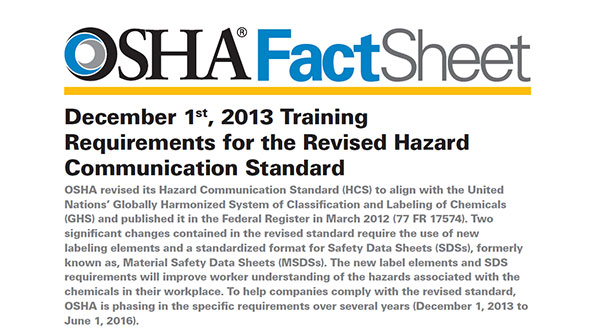This week, OSHA published additional information to help companies get a jump on training employees for the Dec. 1, 2013 HazCom 2012 deadline. That is the date by which employees must be trained on the new label elements and safety data sheet formats.
You can access the Training Requirements document here: http://www.osha.gov/Publications/OSHA3642.pdf
Information on labels and pictograms can be accessed here: http://www.osha.gov/Publications/OSHA3636.pdf
Information on safety data sheets can be accessed here: http://www.osha.gov/Publications/OSHA3514.pdf
Regarding employee training, in addition to explaining the new label elements such as signal words, product identifiers, etc. OSHA recommends employers train workers on how employees can use labels in the work place. Recommendations include:
- Explain how information on the label can be used to ensure proper storage of hazardous chemicals.
- Explain how the information on the label might be used to quickly locate information on first aid when needed by employees or emergency personnel.
- General understanding of how the elements work together on a label. For example,
- Explain that where a chemical has multiple hazards, different pictograms are used to identify the various hazards. The employee should expect to see the appropriate pictogram for the corresponding hazard class.
- Explain that when there are similar precautionary statements, the one providing the most protective information will be included on the label.
Regarding training employees in a language they understand, OSHA provides the following guidance:
OSHA requires employers to present information in a manner and language that their employees can understand. If employers customarily need to communicate work instructions or other workplace information to employees in a language other than English, they will also need to provide safety and health training to employees in the same manner. Similarly, if the employee’s vocabulary is limited, the training must account for that limitation. By the same token, if employees are not literate, telling them to read training materials will not satisfy the employer’s training obligation.
Regarding pictograms, OSHA used to say that a Transport Pictogram and an HCS pictogram for the same hazard shall not appear on the same label. OSHA is stepping back from that and saying both types of pictograms for the same hazard can appear (and actually need to appear for some international shippments).
If a label has a DOT transport pictogram, Appendix C.2.3.3 states that the corresponding HCS pictogram shall not appear. However, DOT does not view the HCS pictogram as a conflict and for some international trade both pictograms may need to be present on the label. Therefore, OSHA intends to revise C.2.3.3. In the meantime, the agency will allow both DOT and HCS pictograms for the same hazard on a label. While the DOT diamond label is required for all hazardous chemicals on the outside shipping containers, chemicals in smaller containers inside the larger shipped container do not require the DOT diamond but do require the OSHA pictograms.
Also the label guidance is much more specific about how to combine and or trim hazard statements and precautionary information in a compliant way. It also states explicitly that workplace labels do not have to have pictograms with red borders. Black borders are allowed. Red of course is still required for shipping labels.
Regarding safety data sheets, OSHA provides a brief paragraph on employee responsibilities:
Employer Responsibilities
Employers must ensure that the SDSs are readily accessible to employees for all hazardous chemicals in their workplace. This may be done in many ways. For example, employers may keep the SDSs in a binder or on computers as long as the employees have immediate access to the information without leaving their work area when needed and a back-up is available for rapid access to the SDS in the case of a power outage or other emergency. Furthermore, employers may want to designate a person(s) responsible for obtaining and maintaining the SDSs. If the employer does not have an SDS, the employer or designated person(s) should contact the manufacturer to obtain one.
Online Training
VelocityEHS offers several GHS / HazCom 2012 training courses that can help employers meet their Dec. 12013 deadline, as well as bolster HazCom training in general.
